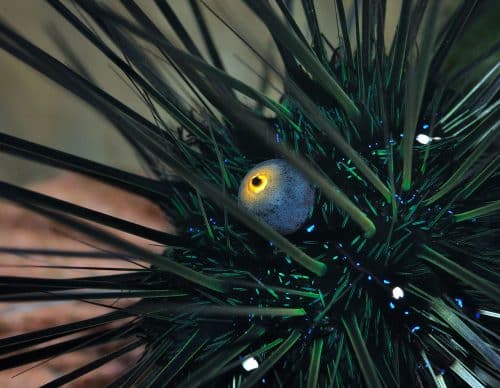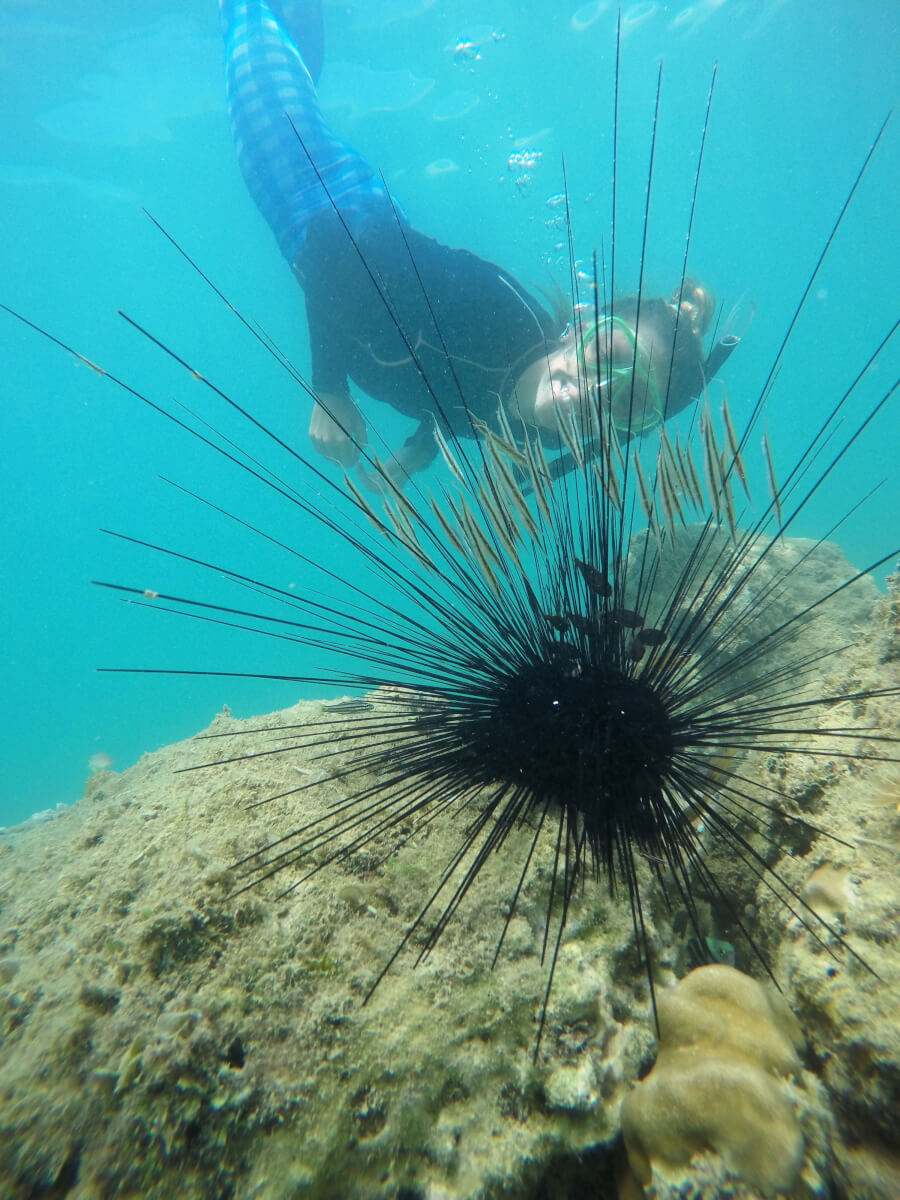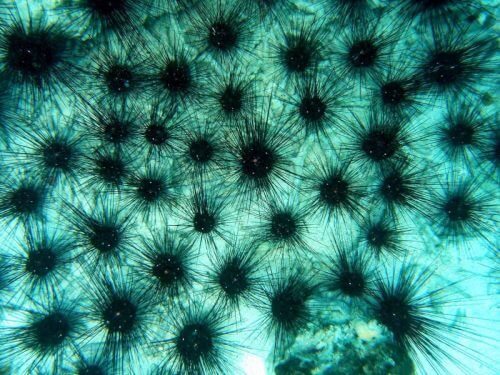The Black Sea urchin is well known to our feet from unpleasant encounters in the Red Sea, but soon we will have to beware of stepping on it on the shores of the Mediterranean as well. How did it get here and what environmental and economic damage could it cause in our area?

By Maya Falah, Angle, Science and Environment News Agency
Anyone who has dived, or just waded, in the Gulf of Eilat must have gotten to know up close the long and sharp spines of the Black Sea urchin, which is very fond of bare feet. Soon, according to an international team of researchers led by an Israeli researcher, we will have to learn to watch out for it on our other beaches as well - since it has managed to invade the Mediterranean Sea.
The Black Sea Urchin (long-thorned nun in Hebrew, or by its Latin name Diadema setosum) is one of the most common of the Red Sea urchins and there we all already know to beware of it - because its sting is not only painful, but can also cause the development of inflammation, due to the toxins found on the spines and in the sea water - which, although not fatal to humans, cause swelling and redness of the area.
According to Dr. Omri Bronstein, a researcher at the Museum of Natural History and History in Vienna who specializes in urchins (the family to which the sea urchin belongs), it seems that in the future bathers in the Mediterranean will also know it. "These hedgehogs, which are among the most common in all the tropical regions of the world and also in the Red Sea, have invaded the Mediterranean and are multiplying there," he says. "In 2006, the first urchin of this species was found on the shores of Turkey - this urchin was collected and is currently in the collections of the Steinhardt Museum of Nature at Tel Aviv University. Since then, this species has been observed in the Mediterranean many more times."
Waiting for the big eruption
"It is true that there is still no official record of this species of urchin on the coast of Israel, but we have no doubt that it is only a matter of time until that happens," says Bronstein with great confidence. It's not just a gut feeling. In a new study, which is published in the magazine Marine Ecology Progress Series, Bronstein examined how this species is likely to spread in the Mediterranean. "We collected all the information that exists on the distribution of this species in the world, and built a model that predicts their spread as an invasive species in the Mediterranean", he says. "We discovered that there is a very high probability that this urchin will spread to all the coasts of Israel and become very common throughout the eastern Mediterranean."
"A problem is expected here," says Bronstein. "Currently we know that since 2006 this urchin is a permanent resident of the Mediterranean Sea. It does flow into the system very, very slowly, but this is what happens in biological invasions: when a species invades a new living area, there is usually an interim period between the initial invasion event and the outbreak of the species in the new area."
According to Bronstein, the window of opportunity for action is closing. "When the sea urchins reach a certain critical mass there will be a big outbreak all at once, and the big fear is that one summer we will wake up and our beaches will simply be full of these urchins," he says. "If we don't act, we may find ourselves facing a problem similar to the one we experience with the wandering jellyfish, that notorious jellyfish that greatly affects our bathing habits."
A carpet of black thorns
How much difference can one species make? According to Bronstein, this is a dramatic matter. The presence of each species has an effect on the balance of the entire system, and the Black Sea urchin is a species that has a significant effect on the habitats in which it lives. "On the coasts of East Africa, for example, these urchins have become very, very common in recent years," says Bronstein, who adds that the heavy fishing load in the area meant that almost all of their natural predators were removed from the system and caused a population explosion of the urchins in the area. "We are talking about certain areas where there are dozens of hedgehogs per square meter. It's a carpet of black thorns for miles - there's no way to even get close and put a foot in the water."
The resorts in the areas where the urchins have invaded and whose livelihood is based on beach tourism, have no choice but to employ on a daily basis dozens of people from the nearby villages who go through the shallow waters from early in the morning and remove the urchins. This is an action that needs to be repeated every day. "This is an extreme example of where something like this can go," emphasizes Bronstein, "and here too - if they don't have predators in the Mediterranean, things can deteriorate to alarming proportions."
Our Mediterranean shores have several species of native sea urchins. The most common of them, known as the purple sea urchin (paracentrotus lividus) is quite different from the black sea urchin: it is smaller than it, its spines are short and not sharp like the black sea urchin and it often hides in narrow crevices in the rocky areas, away from the feet of bathers in the sea.
Unlike the black hedgehog, The purple sea urchin is actually slowly disappearing from the environment. One of the hypotheses is that the warming of the Mediterranean Sea - which according to the forecasts will only get worse due to climate change - is causing the observed decline in the local species. But unlike the purple sea urchins that are not used to temperatures above 30 degrees, this warming actually plays in favor of the invading species.

"The Black Sea urchin comes to the Mediterranean Sea from the Indian Ocean, the Gulf of Eilat and the Persian Gulf and is used to temperatures that the Mediterranean Sea will not reach in many years," says Bronstein. "As the Mediterranean warms, it will only improve their ability to establish themselves there. In addition, since the Black Sea urchin is also adapted to very shallow water - it is already common at a bottom depth of 20 centimeters - it is expected to have an effect on anyone who plans to enter the sea."
Who freed the hedgehogs?
How, in fact, did the black hedgehogs arrive "If we look at the possibility of an invasion through the Suez Canal - as many of the invasive species arrived in the Mediterranean Sea - we would expect Egypt and Israel to be the first countries where we will see these species", says Bronstein, "but although in recent years there is a plan Very extensive monitoring and sampling on the coasts of Israel led by the Nature and Parks Authority, there is still no record of this species in Israel."
"The hypothesis at the moment is that it got there actively by humans, and not by progressing from one site to another from the Suez Canal to the north," says Bronstein. "It could easily have arrived as a larva (puppet) in ballast water in the belly of a ship: ships pump water into their space when they come from the Red Sea and through the Suez Canal, and then everything that is released into the environment in the Mediterranean can establish itself in the new environment. The other possibility is that since it is a species that is also kept in aquariums for display in all kinds of places in the world - it was released into the Mediterranean Sea (intentionally or accidentally) by humans."
So what can be done? Bronstein hopes to bring the matter to the public's attention, to enlighten the attention of the decision-makers to the issue, to get them to act already upon the arrival of the first hedgehogs here, and already now to invest in monitoring the new hedgehogs, with the aim of understanding where they come from and above all formulating a policy regarding the ways of dealing with the problem. "If the decision-makers realize that the outbreak of these sea urchins on our beaches will cause greater economic damage than treating the problem and removing it at an initial stage, perhaps it will help prevent it or at least reduce the dimensions of the outbreak," he concludes.

2 תגובות
You can try to adapt nitsran fish to the area. They eat sea urchins. You can also eat their ovaries.
Interesting and important, but:
It is appropriate that the writer should learn and understand that the "Red Sea" is the foreign name of the Red Sea,
A name originating from a geographically identical mistake and a translation error between English and German,
Those who write in Hebrew must know that
The Gulf of Eilat is an extension of the Red Sea